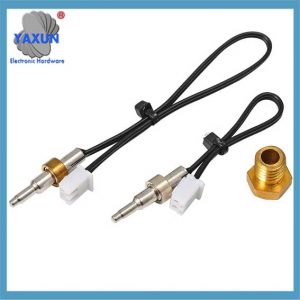在現代工業和汽車電子系統中, 傳感器溫度傳感安全帶被廣泛用於溫度監測, 故障診斷和安全系統作為關鍵傳感技術. 感測器探頭和測溫電纜套件的核心技術涉及溫度感測, 訊號傳輸和資料處理. 溫度採集專家雅迅採用高精度芝浦NTC熱敏電阻用於感測器溫度感測線束, 包括感測材料, 訊號處理技術, 一體化設計及未來發展趨勢.
1. 感應材料
溫度傳感線束的核心在於其感應材料. 現在, 常用的溫度傳感材料包括濕布拉熱敏電阻 (正溫度係數/正溫度係數), 熱電偶和光纖傳感器.
Shibaura熱敏電阻 (正溫度係數/正溫度係數): NTC的電阻值 (負溫度係數) 隨著溫度升高,熱敏電阻降低. PTC相反 (正溫度係數) 熱敏電阻. 通過測量電阻變化, 可以準確獲得溫度信息. 這些材料具有較高的靈敏度和廣泛的溫度測量範圍, 但是他們的應用受環境條件和抵抗穩定性的限制.
熱電偶: 它由兩條不同的金屬線組成,並通過熱電效應產生電壓信號. 熱電偶的溫度範圍很大,穩定性高, 但是它們的信號處理很複雜,需要精確的校準和補償.
光纖傳感器: 光纖溫度傳感技術通過監測光的變化來檢測溫度. 該傳感器具有高靈敏度和抗干擾能力, 並且適合在惡劣環境中進行溫度監測.
2. 信號處理技術
傳感器溫度傳感安全帶的信號處理技術包括兩個部分: 模擬信號轉換和數字信號處理.
模擬信號轉換: 傳感器的信號輸出通常是模擬信號, 需要通過類似物到數字轉換器將其轉換為數字信號 (類比數位轉換器). 在模擬信號轉換過程中, 諸如噪聲抑制等問題, 需要考慮信號放大和過濾以確保信號的準確性和穩定性.
數字信號處理: 數字信號處理技術可以進一步分析和處理傳感器的數字信號輸出. 例如, 算法用於溫度補償, 錯誤校正和數據平滑. 現代溫度傳感安全帶通常會整合微處理器或微控制器,以通過軟件實施複雜的信號處理和數據分析功能.
3. 集成設計
溫度傳感安全帶的集成設計涉及對傳感器的全面考慮, 信號處理單元, 並連接安全帶.
傳感器集成: 將傳感器模塊嵌入線束中可以實現空間節省和緊湊的系統設計. 傳感器的佈局需要考慮溫度測量的準確性和響應速度, 同時確保線束的機械強度和耐用性.
信號傳輸: 在信號傳輸方面, 有必要選擇適當的電線和連接器以減少信號衰減和乾擾. 高質量的屏蔽和絕緣材料可以提高信號傳輸的穩定性.
系統集成: 現代溫度傳感安全帶通常需要與其他電子系統集成, 包括通信接口, 資料儲存, 和處理單元. 系統集成設計需要考慮兼容性, 可靠性, 和可伸縮性以滿足不同的應用程序方案的需求.
4. 未來的發展趨勢
隨著科學技術的進步, 溫度傳感安全帶的技術也在開發. 未來趨勢包括:
智力: 溫度傳感安全帶將逐漸發展為智力, 並實現自我診斷, 自適應調整, 和遠程監視功能通過集成更多的傳感器和處理單元.
小型化: 隨著電子組件的微型化, 溫度傳感安全帶的尺寸將變得越來越小, 適合更緊湊且複雜的應用程序場景.
高可靠性: 未來的溫度傳感安全帶將更加關注可靠性和耐用性,以滿足惡劣環境的應用要求, 例如高溫, 高濕度和強振動環境.
多功能性: 除了傳統的溫度測量功能, 未來的溫度感應安全帶可能會整合更多功能. 例如, 濕度檢測, 壓力測量, ETC。, 提供更全面的環境監控功能.
5. 結論
作為重要的感應技術, Shibaura NTC熱敏電阻溫度感測線束的核心技術包括傳感材料, 信號處理技術和集成設計. 隨著科學技術的發展, 溫度傳感安全帶將在智力方向發展, 小型化和多功能性以滿足更複雜的應用要求. 通過連續的技術創新, 溫度感知安全帶將在行業中起越來越重要的作用, 汽車電子和其他領域.
功能特徵
Shibaura Thermistor元素:
由於使用玻璃封裝, 與樹脂封裝的熱敏電阻相比, 它具有極好的熱量和防風化和更長的使用壽命.
由於鉛線通過金電極粘結到熱電阻芯片, 特徵是穩定的 (psb-s, NS, PL類型的熱敏電阻元件).
特徵
金屬焊接電極的結構
由於鍍錫金屬電極而引起的優質鍍錫
玻璃封裝引起的極好的耐熱性和耐氣性
組裝過程中出色的焊料耐熱性
由於使用方形玻璃, 在實際組裝過程中,不會有較差的固定裝置,例如位移和掉落
申請示例
適用於與SMT相對應的以下溫度測量應用 (表面安裝);
與通用芯片熱敏電阻相比,需要更高可靠性的應用;
工業電機預防過熱;
IGBT的溫度補償 (絕緣柵極晶體管) 裝置;
SMT的一般電子零件的溫度補償 (表面安裝);
工作溫度範圍-50+200℃;
熱時間常數大約 10 秒;
耗散常數約1.4W/℃;
焊料耐熱350℃ 3 秒;
※除非另有說明, 熱時間常數和耗散常數是測試結果.
 English
English العربية
العربية Български
Български 粤语
粤语 中文(简体)
中文(简体) 中文(漢字)
中文(漢字) Nederlands
Nederlands Suomi
Suomi Français
Français Deutsch
Deutsch Ελληνικά
Ελληνικά Magyar
Magyar Italiano
Italiano 日本語
日本語 한국어
한국어 Polski
Polski Português
Português Română
Română Русский
Русский Slovenščina
Slovenščina Español
Español Svenska
Svenska ภาษาไทย
ภาษาไทย Türkçe
Türkçe Tiếng Việt
Tiếng Việt



